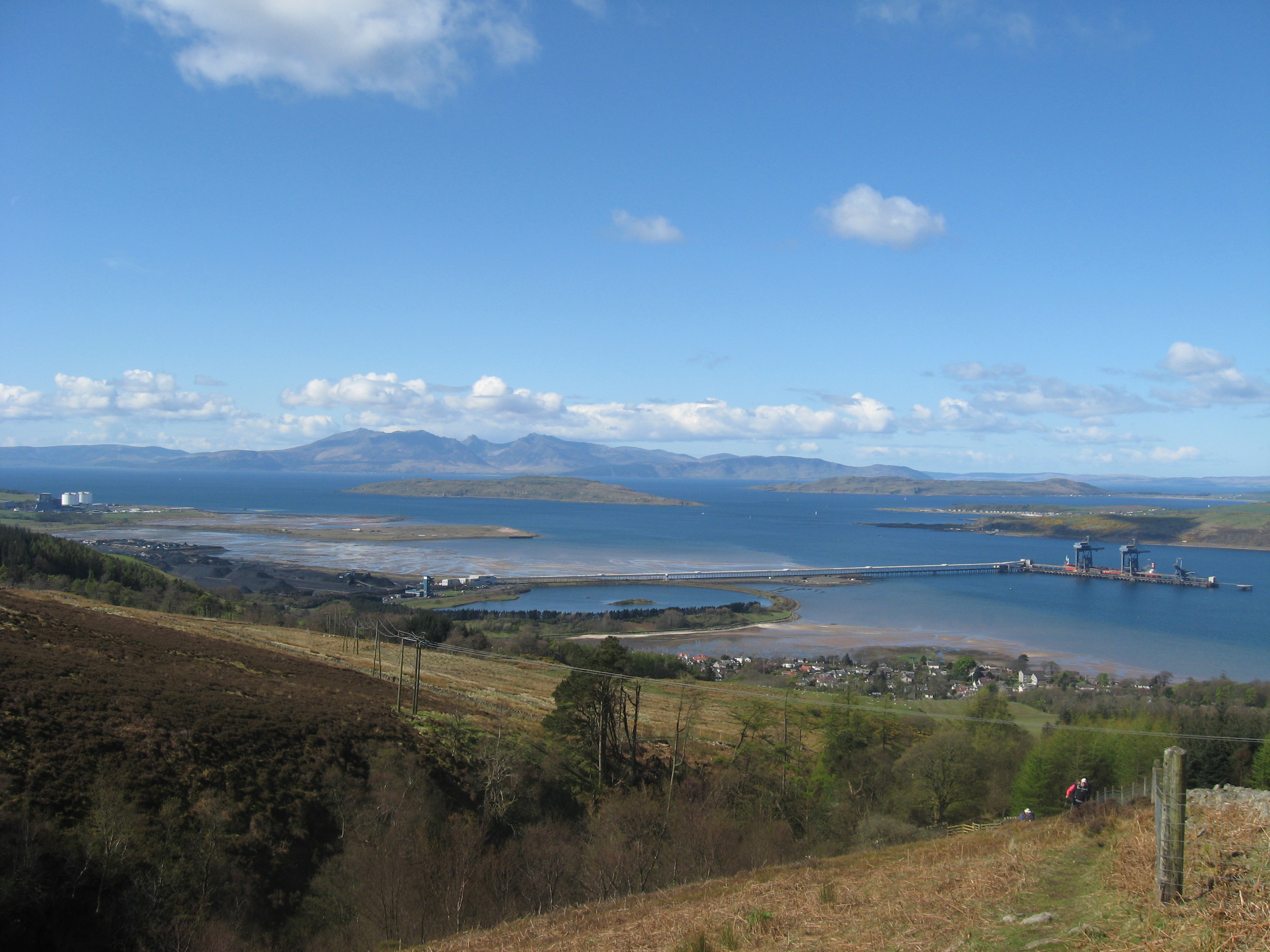Hunterston Terminal on:
[Wikipedia]
[Google]
[Amazon]
Hunterston Terminal, in
 The new port at Hunterston replaced facilities at General Terminus Quay (now Springfield Quay), on the
The new port at Hunterston replaced facilities at General Terminus Quay (now Springfield Quay), on the
 At Hunterston Terminal, an overhead conveyor linked to two
At Hunterston Terminal, an overhead conveyor linked to two
North Ayrshire
North Ayrshire (, ) is one of 32 Council areas of Scotland, council areas in Scotland. The council area borders Inverclyde to the north, Renfrewshire and East Renfrewshire to the northeast, and East Ayrshire and South Ayrshire to the east and s ...
, Scotland, was an iron ore
Iron ores are rocks and minerals from which metallic iron can be economically extracted. The ores are usually rich in iron oxides and vary in color from dark grey, bright yellow, or deep purple to rusty red. The iron is usually found in the f ...
and coal-handling port located at Fairlie on the Firth of Clyde
The Firth of Clyde, is the estuary of the River Clyde, on the west coast of Scotland. The Firth has some of the deepest coastal waters of the British Isles. The Firth is sheltered from the Atlantic Ocean by the Kintyre, Kintyre Peninsula. The ...
, operated by Clydeport which was taken over by The Peel Group in 2003. It lies south of Fairlie, adjacent to Hunterston estate, site of Hunterston Castle, and its jetty projects out approximately , about midway into the channel between the mainland and the island of Great Cumbrae
Great Cumbrae () is the larger of the two islands known as The Cumbraes in the lower Firth of Clyde in western Scotland. The island is sometimes called Millport, Cumbrae, Millport, after its main town.
Home to the Cathedral of The Isles and the ...
.
The port, completed in 1979, was originally called Hunterston Ore Terminal and was built to handle iron ore for British Steel Corporation
British may refer to:
Peoples, culture, and language
* British people, nationals or natives of the United Kingdom, British Overseas Territories and Crown Dependencies.
* British national identity, the characteristics of British people and cultur ...
's Ravenscraig steelworks. Existing facilities at General Terminus Quay on the upper River Clyde
The River Clyde (, ) is a river that flows into the Firth of Clyde, in the west of Scotland. It is the eighth-longest river in the United Kingdom, and the second longest in Scotland after the River Tay. It runs through the city of Glasgow. Th ...
were unsuitable for increasingly large vessels. Hunterston, with its jetty, was able to handle modern ships of any size, but was closed in 2016 and the site cleared in 2019.
History
 The new port at Hunterston replaced facilities at General Terminus Quay (now Springfield Quay), on the
The new port at Hunterston replaced facilities at General Terminus Quay (now Springfield Quay), on the River Clyde
The River Clyde (, ) is a river that flows into the Firth of Clyde, in the west of Scotland. It is the eighth-longest river in the United Kingdom, and the second longest in Scotland after the River Tay. It runs through the city of Glasgow. Th ...
, near the centre of Glasgow
Glasgow is the Cities of Scotland, most populous city in Scotland, located on the banks of the River Clyde in Strathclyde, west central Scotland. It is the List of cities in the United Kingdom, third-most-populous city in the United Kingdom ...
.Campbell, R.H. ''Iron and Steel''. Chapter 5 in: Cunnison and Gilfillan (1958). These facilities had been designed in the early 1950s to allow the simultaneous unloading of two large ships carrying bulk iron ore
Iron ores are rocks and minerals from which metallic iron can be economically extracted. The ores are usually rich in iron oxides and vary in color from dark grey, bright yellow, or deep purple to rusty red. The iron is usually found in the f ...
. The ships were designed to carry 12,000 ton
Ton is any of several units of measure of mass, volume or force. It has a long history and has acquired several meanings and uses.
As a unit of mass, ''ton'' can mean:
* the '' long ton'', which is
* the ''tonne'', also called the ''metric ...
s (12,200 tonne
The tonne ( or ; symbol: t) is a unit of mass equal to 1,000 kilograms. It is a non-SI unit accepted for use with SI. It is also referred to as a metric ton in the United States to distinguish it from the non-metric units of the s ...
s) of iron ore.Sleeman (1958). ''The Present System: The Port of Glasgow To-day''. In Chapter 10 of: Cunnison & Gilfillan (1958). Iron ore was to be transported, in railway waggons, via the General Terminus and Glasgow Harbour Railway, from the General Terminus Quay to the new Ravenscraig steelworks which opened in the late 1950s.
Facilities at Hunterston Terminal
 At Hunterston Terminal, an overhead conveyor linked to two
At Hunterston Terminal, an overhead conveyor linked to two gantry crane
A gantry crane is a Crane (machine), crane built atop a wikt:gantry, gantry, which is a structure used to straddle an object or workspace. They can range from enormous "full" gantry cranes, capable of lifting some of the heaviest loads in the wor ...
s carried ore or coal to a railhead
{{Short pages monitor